Honeysuckle is perceived in different ways. For some, it’s a "wolfberry," while for others — a secret to eternal youth and longevity. The flesh of honeysuckle contains vitamins A, C, and E, as well as a unique complex of minerals and trace elements. If 50 years ago honeysuckle was grown mainly in northern and temperate regions, today this berry is popular even in the south. Many varieties yield abundant harvests and serve as natural garden hedges.
Best Varieties of Edible Honeysuckle
Honeysuckle is used in folk medicine, cosmetics, and cooking. The berries are renowned for their taste and health benefits.
Let’s explore the best varieties of edible honeysuckle, their advantages, and unique characteristics.
The Sweetest Varieties
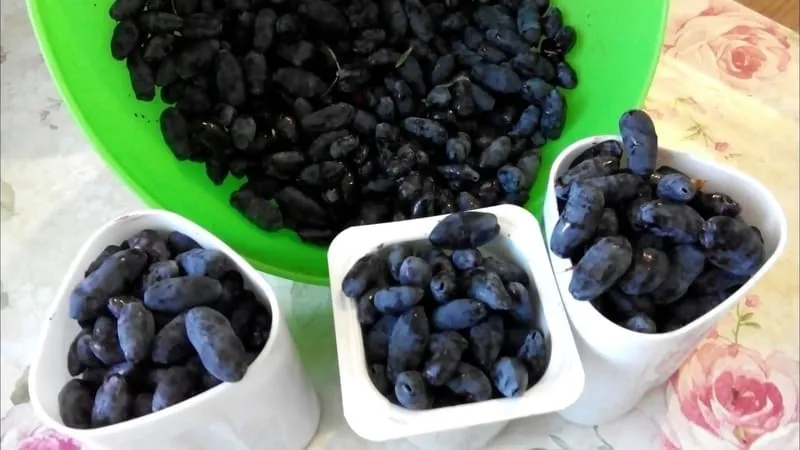
Most honeysuckle varieties have a tart and slightly bitter taste — which is why they are less popular than beloved cherries or raspberries. Therefore, when choosing a variety, special attention is paid to flavor, favoring the sweetest options.
Bluebell
The bush is tall, reaching up to 2 m in height. The crown is rounded, with curved shoots and matte green leaves. The berries are oblong, weighing about 1 g. The taste is delicate, with pleasant flesh and no bitterness. The skin is thin, blue-violet with a white bloom.
Bluebell ripens gradually, and due to its thin skin, it is unsuitable for commercial cultivation and sale. The yield is stable — gardeners harvest about 7 kg of berries per bush annually.
Golden Drop
The bushes are tall with dense foliage. The leaves are medium-sized, and the shoots are strong. The berries weigh 1–1.2 g, with a rounded-oval shape and a pointed tip. The color is blue with a purple tint. The flesh is juicy and sweet, with a rich aroma.
Each season, gardeners collect about 4 kg per plant. The berries are used fresh or for preserves — honeysuckle makes delicious marmalade, jam, and confiture.
Royal Jewel
This mid-late variety features tall bushes with spreading shoots. The leaves are thick and matte, and the flowers are yellow. The berries weigh about 1.2 g, with a length of 1–4 cm. The shape is cylindrical, the skin is medium-thick with slight fuzz. The flesh is aromatic and juicy, without bitterness.
The yield of Royal Jewel is about 2 kg per plant. Honeysuckle is undemanding to soil, but it thrives best in moisture-retaining loamy soils.
High-Yielding Varieties
Honeysuckle’s yield depends on the growing region, soil condition, weather, and proper care. On average, one bush yields 2–4 kg per summer. However, some varieties are more productive, consistently yielding 5 kg or more.
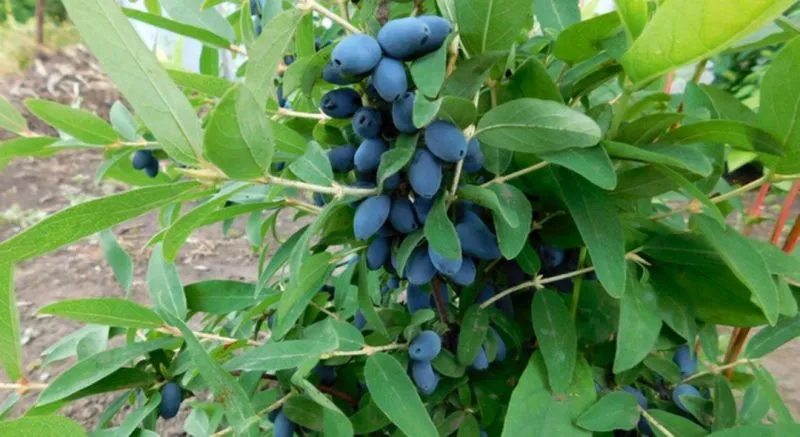
Fire Opal
This hardy variety is suitable for growing in Scandinavia and the Alpine regions — it adapts quickly to sudden weather changes and is cold-resistant. The bush reaches 1.5 m in height, with a compact crown. The flesh is sweet, with a delicate taste and a slightly tart aftertaste. The fruits are purple-blue and elongated. The berries do not fall off after ripening. The yield is about 6 kg per plant. Honeysuckle is eaten fresh or processed.
New Dawn
The bushes are compact with a spherical crown, ideal for small gardens. The ripening period begins in late June. The flesh is pleasant, sweet with a hint of tartness. The berries weigh about 1 g, with a cylindrical-elongated shape. The color is dark blue, and the skin is thin. The yield is 6 kg per bush. New Dawn is resistant to spider mites and aphids and requires minimal care.
Northern Star
This high-yielding variety is popular in Central and Northern Europe. The yield is 4–5 kg per bush per summer. The berries are smooth, oval, weighing 0.8–1.2 g, with an average length of 2 cm. The plant bears fruit in the second or third year after planting. The taste is sweet-tart with a pronounced berry aroma. The flesh is tender, and the skin is medium-thick.
Note! A bitter taste in honeysuckle is often caused by improper care — insufficient watering, poor drainage, or lack of mineral and organic fertilizers. Another reason for bitter flesh is an unsuitable planting location. Honeysuckle does not thrive in acidic soils.
Large-Fruited Varieties
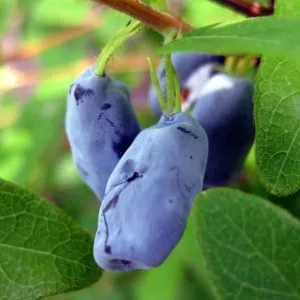
Large honeysuckle berries are delicious in any form — eaten with milk or cream, added to tea with sugar, or used in fruit-berry desserts.
To grow large berries, proper planting and care are essential.
Garden Treasure
One of the most popular honeysuckle varieties in Europe. The bush reaches about 1.6 m in height, with strong shoots and dense foliage. The berries are up to 4 cm long, weighing around 3 g. The fruits resemble miniature bananas, with a purple-blue color.
The taste is sweet, without bitterness. The yield is 3–4 kg per bush. Gardeners recommend paying attention to fertilization — honeysuckle reacts to mineral and vitamin deficiencies.
Harmony
The plant grows up to 2 m tall, so a spacious planting area is recommended. The berries are rounded-oval, weighing about 1.5 g. The taste is sweet with a slight tartness, and the flesh is firm. The berries do not crack when ripe and are suitable for storage and transport. The harvest is used for drying, freezing, and preserves.
Nymph
The plant is tall, reaching up to 1.8 m. The berries are up to 3 cm long, weighing about 2 g. The taste is juicy and sweet, with tender flesh. The color is blue with a waxy coating. Another advantage of Nymph is its resistance to fungal diseases and stable yield — about 2 kg per plant.
How to Choose the Right Honeysuckle
The planting region is the key factor in yield. Climate conditions determine the number of ripe berries, their shelf life, weight, and appearance. Some varieties tolerate weather changes well and are suitable for northern regions. Others only thrive in warm climates.
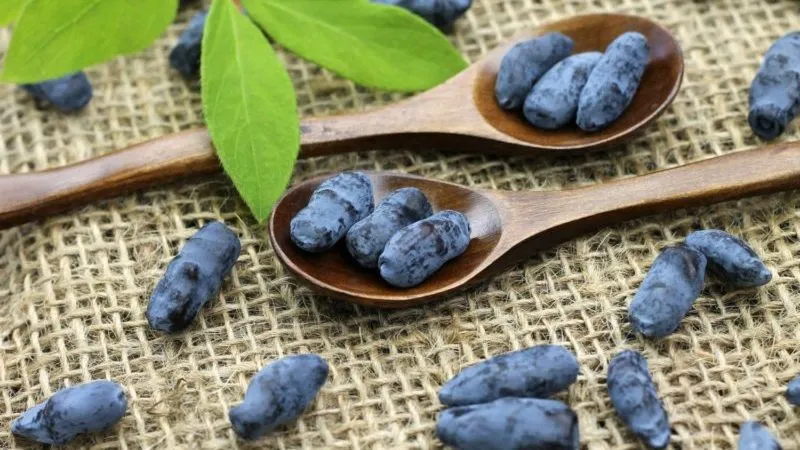
For Northern and Alpine Regions
Northern and Alpine regions have short, cool summers, frequent frosts, and harsh winds. For planting, choose frost-resistant varieties with immunity to viral and fungal diseases.
Winter Gem
The bush grows up to 2 m tall, with a compact crown and upright shoots. The plant is visually appealing, often used as a hedge. The berries are pear-shaped, weighing about 1 g. The taste is pleasant, moderately sweet. The yield ranges from 2 to 4 kg per bush.
Thanks to the thick skin, the berries transport well. Winter Gem is resistant to powdery mildew and rot and is rarely affected by aphids or other pests.
Joyful Heart
This mid-late variety is grown in areas with limited sunlight. The shrubs are neat, enhancing any garden. The berries weigh 0.7–1 g, with an oval-elongated shape and a blue color with a waxy coating.
Each bush yields 2–3 kg, used fresh or for sale. Joyful Heart is perfect for making sweets — marshmallows, marmalade, and jelly.
Cinderella
The bush grows up to 0.7 m tall, with spreading shoots. The berries are elongated and pointed at the tip. The average weight is 1 g, with a waxy coating and deep blue color. The taste is refreshing, sweet-tart, with juicy and aromatic flesh.
The fruiting period begins in mid-to-late June. If the summer is cool and rainy, Cinderella ripens gradually. The yield is 3 kg per bush.
For Central and Western Europe

Honeysuckle grown in Central and Western Europe must be drought-resistant. Choose varieties that do not crack under prolonged dryness, retaining their beneficial, commercial, and taste qualities.
Blue Bird
This universal variety thrives in nutrient-rich, loose soil. The bush grows up to 1.5 m tall, with thin shoots and a dense, spreading crown. The berries are up to 2 cm long, weighing about 1 g. The skin is thin, with a waxy coating. The color is blue-violet and matte. The taste resembles wild blueberries — sweet-tart with a slightly tangy note. The yield ranges from 2 to 4 kg, depending on weather and cultivation practices.
Amphora
The mid-late variety grows up to 1.5 m tall. The round, compact crown enhances any garden. The berries are 2 cm long, weighing 2–3 g. The surface is smooth, with a blue-violet color and a strong waxy coating. The taste is sweet-tart, with hints of wild berries. The harvest is transportable, ideal for juices and compotes.
Silvia
This variety is high-yielding, frost-resistant, and low-maintenance. Suitable for Central Europe, especially in regions with unpredictable weather. The berries are large, weighing 1–1.5 g. The taste is fresh and sweet, without bitterness. The color is purple-blue with a waxy coating. The skin is thin, with a pleasant berry aroma.
The berries ripen uniformly, clinging firmly to the branches without falling. The yield per bush ranges from 1.5 to 3 kg.
Polina
A fast-growing, low-maintenance variety gaining popularity. The berries are large and free of bitterness. The plant is disease-resistant and frost-hardy. The harvest is prized for its taste and attractive commercial qualities.
For Coastal and Northwestern Regions
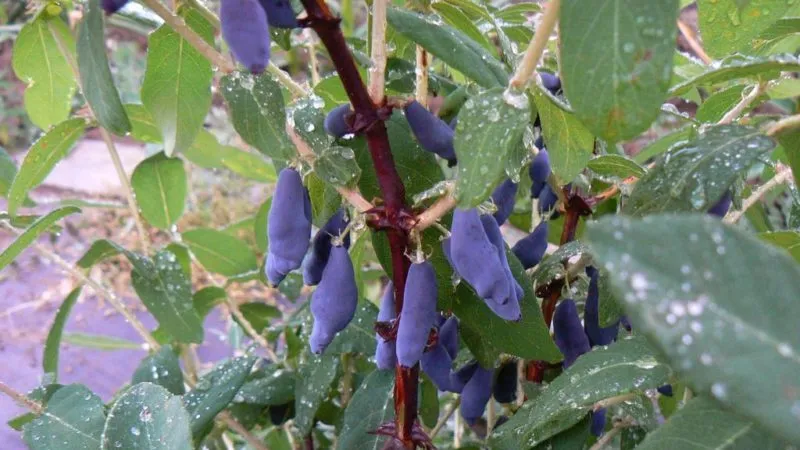
Honeysuckle bushes in coastal regions are compact and low-growing, often used for hedges. Choose varieties resistant to high humidity, temperature fluctuations, and infections.
Omega
The bush grows up to 1.5 m tall, with a compact crown and medium-sized shoots. The berries are oval, deep blue with a light waxy coating. The thick skin ensures long shelf life, making them suitable for transport. The average weight is 1 g. Omega is frost-resistant, rarely diseased, and grown in private gardens and commercial farms.
Blue Spindle
This early variety, originally from Northern Europe, is also suitable for coastal regions. It tolerates high humidity and requires minimal care. The berries are up to 3 cm long, weighing about 1 g. The surface is slightly bumpy, with a blue-violet color. The skin is thick, and the flesh is sweet-tart with a subtle aroma. The berries are best used for processing — they make excellent jams and preserves.
Violet
This mid-early variety is known for its attractive compact bushes and large berries. Each berry weighs about 1.5 g, with some reaching 2 g. The surface is bumpy, the skin is thick, and the color is blue with a waxy coating. The flesh is sweet-tart, without bitterness. The berries are versatile, do not fall off, and retain their firmness and flavor after harvest. Each bush yields about 2.5 kg per season.
Interesting! Honeysuckle is essential for a traditional Hungarian dish — retes. This pie is filled with honeysuckle, apricots, honey, butter, and starch. A unique treat for those who want to delight their loved ones with a delicious and healthy dessert.
For Mountainous and Harsh Climates
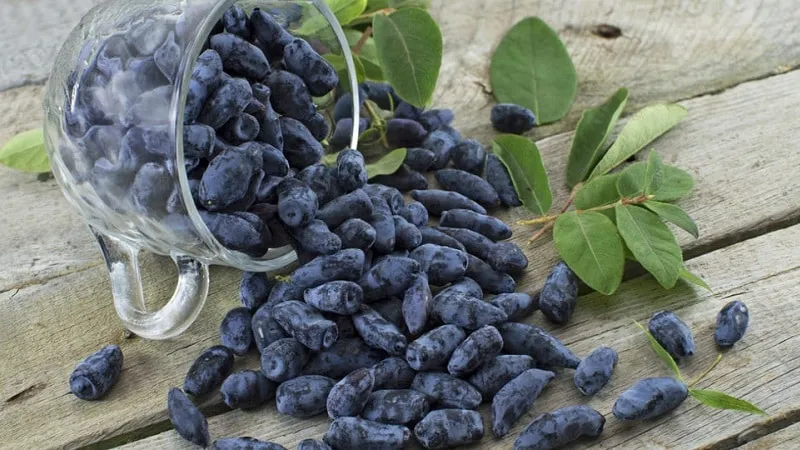
Mountainous regions experience unpredictable weather — heat, fog, heavy rains, and even frost or snow in summer. Choose frost-resistant and drought-tolerant varieties with stable yields.
Enchantress
This mid-season variety thrives in loamy and sandy soils. The bush grows up to 1.5 m tall, with a spherical crown. The berries weigh about 1.6 g, with a pear-like shape and a blue color with a silvery bloom. The flesh is dense, sweet with a slight tang. The yield is 2–3 kg per plant. Enchantress bears fruit consistently, and the berries are firm. It is resistant to rodents and insects.
Sunny Gem
The bushes are medium-sized with curved shoots. The berries are large and elongated, weighing up to 1.5 g. The ripening period is early, with a yield of 1–2 kg per bush. The skin is thick and bumpy, and the flesh is fibrous and sweet. Sunny Gem is frost-resistant but requires regular mineral fertilization for larger berries. Thanks to its dessert-like taste, it is often eaten fresh. For longer storage, the berries are mashed with sugar.
Belle Époque
The bush is wide-spreading and requires ample space. The berries are dark blue, rounded, resembling small barrels. The average weight is about 1 g. The flesh is very sweet, without bitterness. The yield is up to 2 kg per bush. The berries tend to fall, so the harvest is collected 2–3 times per season. The variety is versatile in use.
Conclusion
For culinary use, sweet and juicy varieties without bitterness are recommended — Golden Drop, Garden Treasure, and Nymph. These berries are aromatic, with tender flesh. For long-term storage, choose varieties with thick skin and a waxy coating — Omega, Violet, and Enchantress.
Plant honeysuckle in sunny, spacious areas, away from other fruit and berry plants. Harvest as the berries ripen, and wear gloves to avoid rubbing off the waxy coating — it helps preserve freshness and nutrients.







